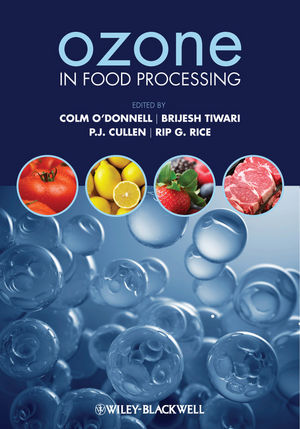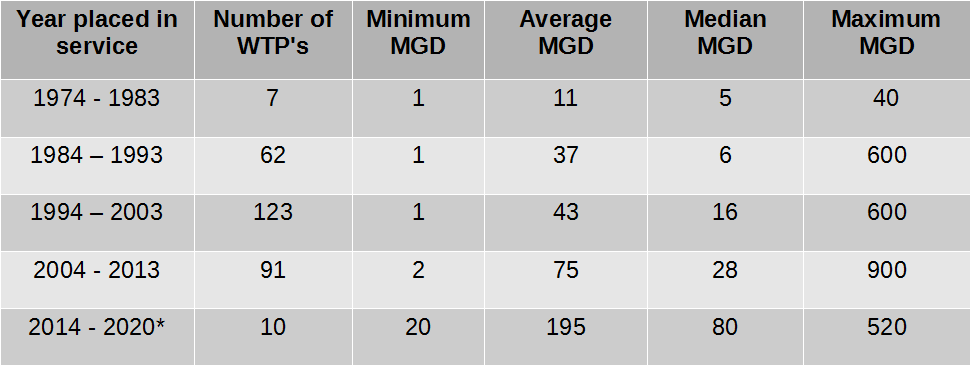A great resource available to help with the implementation of ozone in food processing is a book called “Ozone in Food Processing” written by Colm O’Donnell, Mrijesh K. Tiwari, P.J. Cullen, and Rip G. Rice. This book is a great handbook on the basics of implementing ozone in food processing applications around the world.
This book provides comprehensive information on the use of ozone in food processing. It covers current state-of-the-art techniques and reviews established and emerging applications for food preservation, processing, and waste management. The book explains ozone’s chemical and physical properties, microbial inactivation mechanisms, and various methods of production (including economic and technical aspects). It focuses on major food processing applications, such as fruits and vegetables, grains, meat, seafood, and hydrocolloids, and discusses the impact on nutritional and quality parameters. The book also explores ozone’s role in water treatment, food waste treatment, and deactivating pesticide residues, and examines international regulations and health and safety concerns. Finally, the book provides insight into potential future trends in ozone processing.
This book is available as one of the references from the International Ozone Association. Click HERE for purchase info.
Learn more about ozone in food processing HERE
TABLE OF CONTENTS
Contributors xi
1 Status and Trends of Ozone in Food Processing 1
Colm O’Donnell, B.K. Tiwari, P.J. Cullen and Rip G. Rice
1.1 Why ozone? 1
1.2 Drivers of ozone in the food industry 1
1.2.1 Regulation 1
1.2.2 Surface cleaning and disinfection 2
1.2.3 Food safety and shelf life extension 2
1.2.4 Nutrient and sensory aspects 3
1.2.5 Consumer and processor acceptability 3
1.2.6 Technology advances 3
1.2.7 Environmental impact 4
1.3 The hurdle concept 4
1.4 Challenges 5
1.5 Objective 5
References 5
2 Regulatory and Legislative Issues 7
B.K. Tiwari and Rip G. Rice
2.1 Introduction 7
2.2 History of ozone application and regulation 9
2.3 Ozone regulation 9
2.3.1 Overview of US regulations 9
2.3.2 Overview of European regulations 11
2.3.3 Overview of Canadian regulations 13
2.3.4 Overview of Australian and New Zealand regulations 15
2.3.5 Overview of Japanese regulations 15
2.4 Global harmonisation of food safety regulations 16
References 16
3 Chemical and Physical Properties of Ozone 19
Annel K. Greene, Zeynep B. Güzel-Seydim and Atıf Can Seydim
3.1 Introduction 19
3.2 The molecular structure of ozone 19
3.3 The chemical and physical properties of ozone 20
3.3.1 The chemical mechanisms of ozonation 22
3.3.2 Ozone reaction pathways in water 22
3.4 Ozone action on macromolecules 25
3.5 Mechanisms of microbial inactivation 26
3.6 Ozone reactions against virus 28
3.7 Ozone reaction on biofilms 29
Acknowledgments 29
References 29
4 Generation and Control of Ozone 33
Cameron Tapp and Rip G. Rice
4.1 Introduction 33
4.2 Ozone generation 33
4.2.1 Ozone generation by corona discharge (CD) 34
4.2.2 Ultraviolet (UV) (photochemical) ozone generation 36
4.3 Feed gas preparation systems 36
4.3.1 Need for feed gas treatment 36
4.3.2 Air preparation systems 37
4.3.3 Oxygen feed gas systems 39
4.4 Solubility of ozone in water 41
4.5 Contacting ozone with water: physical means of transferring ozone into water 44
4.5.1 Venturi injection method 44
4.5.2 Fine bubble diffuser method 46
4.6 Measuring and monitoring ozone in water 46
4.6.1 Colourimetric method 47
4.6.2 Electronic method – for dissolved ozone 47
4.6.3 Electronic method – for ORP 48
4.7 Measuring and monitoring ozone in air 48
4.7.1 Ozone measurement equipment for food processing plant air 49
4.8 Ozonation equipment for food storage rooms 50
4.9 Ozone generator output control 50
4.10 Some recent novel applications for ozone generation in food processing plants 51
4.11 Helpful calculations 53
4.11.1 Gallons per minute 53
4.11.2 Metric equivalent 53
References 53
5 Ozone in Fruit and Vegetable Processing 55
B.K. Tiwari and K. Muthukumarappan
5.1 Introduction 55
5.2 Applications in fruit and vegetable processing 56
5.2.1 Surface decontamination 56
5.2.2 Storage in ozone-rich atmospheres 61
5.2.3 Ozone in fruit and vegetable juice processing 65
5.3 Efficacy of ozone 65
5.4 Synergistic effects with ozone 68
5.5 Effect of ozone on product quality and nutrition 69
5.5.1 Chemical attributes 69
5.5.2 Visual quality 70
5.5.3 Texture 72
5.5.4 Sensory quality 73
5.6 Conclusion 74
References 74
6 Ozone in Grain Processing 81
V. Lullien-Pellerin
6.1 Introduction 81
6.2 Ozone application in grain storage and effects on grain components 82
6.2.1 Insect control 82
6.2.2 Microorganism control 84
6.2.3 Reduction of toxic chemical levels 86
6.2.4 Effects of ozone on grain components, metabolism and physiological status 88
6.3 Effects of ozone on grain processing, flour and product quality 90
6.4 Industrial applications and scale-up 93
6.5 Conclusions 95
Acknowledgments 96
References 96
7 Ozonation of Hydrocolloids 103
Joan M. King, Hee-Jung An, Seung-wook Seo and Alfredo Prudente
7.1 Introduction 103
7.2 Application of ozone in hydrocolloid processing 104
7.2.1 Starch 104
7.2.2 Chitosan 105
7.2.3 Gelatin 107
7.2.4 Other hydrocolloids 108
7.3 Effects of ozone on the physiochemical properties of hydrocolloids 108
7.3.1 Structural composition 108
7.3.2 Swelling power 109
7.3.3 Molecular weight 110
7.3.4 Viscosity 111
7.3.5 Thermal properties 115
7.4 Mechanism and structural effects of ozone action on hydrocolloids 115
References 118
8 Ozone in Meat Processing 123
Fred W. Pohlman
8.1 Introduction 123
8.2 Application of ozone in meat processing 125
8.2.1 Surface decontamination of red meat 125
8.2.2 Surface decontamination of poultry 128
8.2.3 Other meat applications 129
8.3 Effect on meat quality 130
References 133
9 Ozone in Seafood Processing 137
Shigezou Naito
9.1 Introduction 137
9.2 Application of ozone in fish and storage of processed seafood products 138
9.2.1 Fresh fish and seafood 138
9.2.2 Dried and smoked products 145
9.3 Application of ozone in seafood plant sanitation 149
9.4 Effects of ozone on microbial safety 153
9.5 Effects of ozone on fish and seafood quality and shelf life 155
9.6 Current status and future trends for ozone and seafood 157
References 160
10 Ozone Sanitisation in the Food Industry 163
P.J. Cullen and Tomás Norton
10.1 Introduction 163
10.2 Ozone as a sanitising agent 165
10.3 Health and safety issues 168
10.4 Using ozone in industrial cleaning procedures 168
10.5 Ozone applications in food processing 170
10.5.1 Dairy industry 170
10.5.2 Wine industry 172
10.5.3 Brewing industry 173
References 174
11 Ozone for Water Treatment and its Potential for Process Water Reuse in the Food Industry 177
Tomás Norton and Paula Misiewicz
Nomenclature 177
11.1 Introduction 177
11.2 Water in the food industry 179
11.2.1 Fresh produce processing 180
11.2.2 Dairy processing 181
11.2.3 Meat and poultry processing 185
11.3 Ozonation as a water treatment process 185
11.4 The kinetics of ozonation 187
11.4.1 The kinetics of mass transfer 188
11.4.2 Determining the chemical reaction kinetics 189
11.4.3 Hydrodynamics 191
11.4.4 Applications of hydrodynamic modelling to investigate ozone water treatment 193
11.5 Conclusion 195
References 195
12 Ozone for Food Waste and Odour Treatment 201
Ioannis S. Arvanitoyannis
12.1 Introduction 201
12.2 Application of ozonation to waste treatment 205
12.2.1 Wastewater of plant origin 205
12.2.2 Wastewater of animal origin 209
12.3 Application of ozonation to odour removal 211
12.3.1 Odours originating from food industry processes 213
12.3.2 Odours originating from agricultural operations 213
12.4 Conclusions 216
References 216
13 Efficacy of Ozone on Pesticide Residues 223
Gilbert Y.S. Chan and J.G. Wu
13.1 Introduction 223
13.2 Types of pesticides 225
13.3 Fates of pesticides 225
13.3.1 Degradation processes of pesticides 225
13.3.2 Ozonation of pesticides 227
13.4 Degradation mechanisms 227
13.4.1 Kinetics 227
13.4.2 Intermediates and oxidation products 229
13.5 Ozone application for pesticide residues in fruits and vegetables 231
13.6 Current status and opportunities 234
13.6.1 Ozone concentrations 234
13.6.2 Physical nature of plants affects degradation efficacy 235
13.6.3 Future trends 235
References 236
14 Modelling Approaches for Ozone Processing 241
Vasilis P. Valdramidis, P.J. Cullen and B.K. Tiwari
Nomenclature 241
14.1 Introduction 242
14.2 Modelling approaches for microbial inactivation 242
14.3 Chemical reaction kinetics 250
14.4 Modelling ozonation processes 255
14.4.1 Modelling ozone bubble columns 255
14.4.2 Overall mass transfer coefficient 257
14.5 Conclusions 259
References 259
15 Health and Safety Aspects of Ozone Processing 265
Rip G. Rice
15.1 Introduction 265
15.2 Points of application of ozone during food processing 266
15.2.1 Aqueous phase ozone applications 266
15.2.2 Gas phase ozone applications 267
15.3 Health and safety issues with ozone for food plant workers 267
15.3.1 Ozone exposure regulations 267
15.3.2 Potential fire hazards from high-purity oxygen use 271
15.3.3 Safety history of ozone in commercial/industrial applications 272
15.4 Avoiding worker exposure to ozone in food processing plants 273
15.4.1 General considerations 273
15.4.2 Specific plant safety measures 274
15.4.3 Controlling off-gas ozone at Fresher Than Fresh fish processing/packaging plant 275
15.4.4 Third-party evaluation of aqueous ozone spray wash equipment 277
15.5 Safety of foods processed with ozone 280
15.5.1 Nutrient impacts of ozone contact with foods 280
15.5.2 Impacts of ozone processing of foods on vitamin contents 281
15.5.3 Impacts of ozone processing of foods on protein contents 282
15.5.4 Impacts of ozone processing of foods on lipid contents 283
15.5.5 Toxicology aspects of ozone processing of foods 283
15.6 Conclusions 285
Acknowledgments 286
References 286
Index 289
A colour plate section falls between pages 180 and 181


